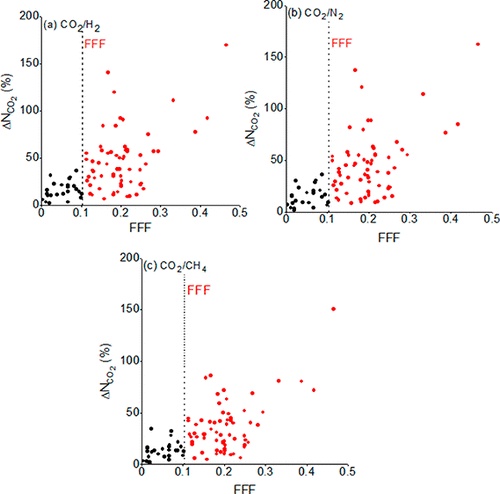当前位置:
X-MOL 学术
›
Ind. Eng. Chem. Res.
›
论文详情
Our official English website, www.x-mol.net, welcomes your feedback! (Note: you will need to create a separate account there.)
Effects of Force Field Selection on the Computational Ranking of MOFs for CO2 Separations.
Industrial & Engineering Chemistry Research ( IF 4.2 ) Pub Date : 2018-01-18 , DOI: 10.1021/acs.iecr.7b04792 Derya Dokur 1 , Seda Keskin 1
Industrial & Engineering Chemistry Research ( IF 4.2 ) Pub Date : 2018-01-18 , DOI: 10.1021/acs.iecr.7b04792 Derya Dokur 1 , Seda Keskin 1
Affiliation

|
Metal-organic frameworks (MOFs) have been considered as highly promising materials for adsorption-based CO2 separations. The number of synthesized MOFs has been increasing very rapidly. High-throughput molecular simulations are very useful to screen large numbers of MOFs in order to identify the most promising adsorbents prior to extensive experimental studies. Results of molecular simulations depend on the force field used to define the interactions between gas molecules and MOFs. Choosing the appropriate force field for MOFs is essential to make reliable predictions about the materials' performance. In this work, we performed two sets of molecular simulations using the two widely used generic force fields, Dreiding and UFF, and obtained adsorption data of CO2/H2, CO2/N2, and CO2/CH4 mixtures in 100 different MOF structures. Using this adsorption data, several adsorbent evaluation metrics including selectivity, working capacity, sorbent selection parameter, and percent regenerability were computed for each MOF. MOFs were then ranked based on these evaluation metrics, and top performing materials were identified. We then examined the sensitivity of the MOF rankings to the force field type. Our results showed that although there are significant quantitative differences between some adsorbent evaluation metrics computed using different force fields, rankings of the top MOF adsorbents for CO2 separations are generally similar: 8, 8, and 9 out of the top 10 most selective MOFs were found to be identical in the ranking for CO2/H2, CO2/N2, and CO2/CH4 separations using Dreiding and UFF. We finally suggested a force field factor depending on the energy parameters of atoms present in the MOFs to quantify the robustness of the simulation results to the force field selection. This easily computable factor will be highly useful to determine whether the results are sensitive to the force field type or not prior to performing computationally demanding molecular simulations.
中文翻译:

力场选择对用于CO2分离的MOFs计算排名的影响。
金属有机框架(MOF)已被认为是用于基于吸附的CO2分离的极有前途的材料。合成MOF的数量一直在迅速增加。高通量分子模拟对于筛选大量MOF很有用,以便在进行广泛的实验研究之前鉴定出最有希望的吸附剂。分子模拟的结果取决于用来定义气体分子与MOF之间相互作用的力场。为MOF选择合适的力场对于可靠地预测材料的性能至关重要。在这项工作中,我们使用两个广泛使用的通用力场Dreiding和UFF进行了两组分子模拟,并获得了100种不同MOF结构中CO2 / H2,CO2 / N2和CO2 / CH4混合物的吸附数据。使用该吸附数据,为每个MOF计算了几种吸附剂评估指标,包括选择性,工作容量,吸附剂选择参数和可再生性百分比。然后根据这些评估指标对MOF进行排名,并确定表现最佳的材料。然后,我们检查了MOF排名对力场类型的敏感性。我们的结果表明,尽管使用不同的力场计算出的某些吸附剂评估指标之间存在显着的定量差异,但用于CO2分离的顶级MOF吸附剂的排名通常相似:在前10个最具选择性的MOF中,分别找到了8、8和9种使用Dreiding和UFF在CO2 / H2,CO2 / N2和CO2 / CH4分离方面的排名是相同的。最后,我们根据MOF中存在的原子的能量参数提出了一个力场因子,以量化仿真结果对力场选择的鲁棒性。这个易于计算的因子在执行计算要求较高的分子模拟之前,对于确定结果是否对力场类型敏感非常有用。
更新日期:2018-01-31
中文翻译:

力场选择对用于CO2分离的MOFs计算排名的影响。
金属有机框架(MOF)已被认为是用于基于吸附的CO2分离的极有前途的材料。合成MOF的数量一直在迅速增加。高通量分子模拟对于筛选大量MOF很有用,以便在进行广泛的实验研究之前鉴定出最有希望的吸附剂。分子模拟的结果取决于用来定义气体分子与MOF之间相互作用的力场。为MOF选择合适的力场对于可靠地预测材料的性能至关重要。在这项工作中,我们使用两个广泛使用的通用力场Dreiding和UFF进行了两组分子模拟,并获得了100种不同MOF结构中CO2 / H2,CO2 / N2和CO2 / CH4混合物的吸附数据。使用该吸附数据,为每个MOF计算了几种吸附剂评估指标,包括选择性,工作容量,吸附剂选择参数和可再生性百分比。然后根据这些评估指标对MOF进行排名,并确定表现最佳的材料。然后,我们检查了MOF排名对力场类型的敏感性。我们的结果表明,尽管使用不同的力场计算出的某些吸附剂评估指标之间存在显着的定量差异,但用于CO2分离的顶级MOF吸附剂的排名通常相似:在前10个最具选择性的MOF中,分别找到了8、8和9种使用Dreiding和UFF在CO2 / H2,CO2 / N2和CO2 / CH4分离方面的排名是相同的。最后,我们根据MOF中存在的原子的能量参数提出了一个力场因子,以量化仿真结果对力场选择的鲁棒性。这个易于计算的因子在执行计算要求较高的分子模拟之前,对于确定结果是否对力场类型敏感非常有用。


























 京公网安备 11010802027423号
京公网安备 11010802027423号